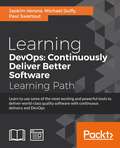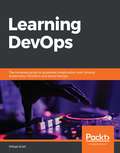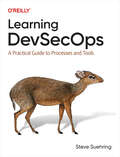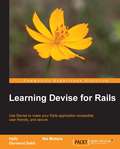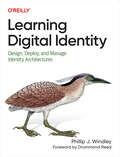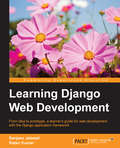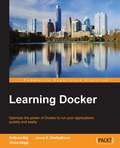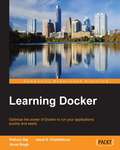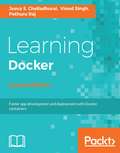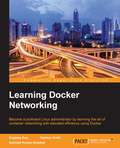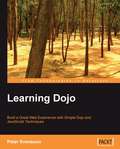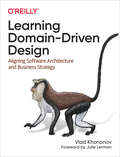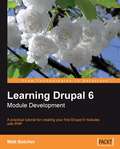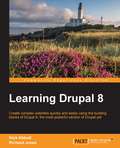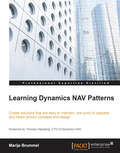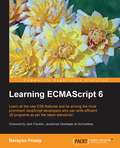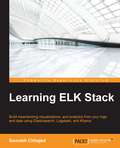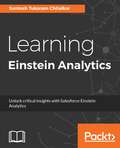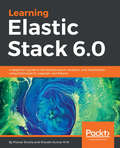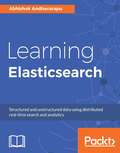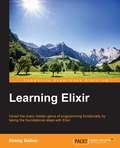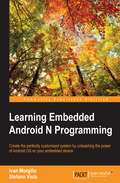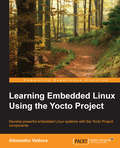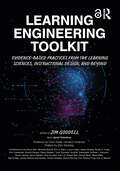- Table View
- List View
Learning DevOps: Continuously Deliver Better Software
by Michael Duffy Paul Swartout Joakim VeronaLearn to use some of the most exciting and powerful tools to deliver world-class quality software with continuous delivery and DevOps About This Book * Get to know the background of DevOps so you understand the collaboration between different aspects of an IT organization and a software developer * Deploy top-quality software and ensure software maintenance and release management with this practical guide * This course covers some of the most exciting technology available to DevOps engineers, and demonstrates multiple techniques for using them * Real-world and realistic examples are provided to help you as you go about the implementation and adoption of continuous delivery and DevOps Who This Book Is For This course is for developers who want to understand how the infrastructure that builds today's enterprises works, and how to painlessly and regularly ship quality software. What You Will Learn * Set up and familiarize yourself with all the tools you need to be efficient with DevOps * Design an application that is suitable for continuous deployment systems with DevOps in mind * Test the code using automated regression testing with Jenkins Selenium * Managing the lifecycle of hosts, from creation to ongoing management using Puppet Razor * Find out how to manage, use, and work with Code in the Git version management system * See what traps, pitfalls, and hurdles to look out for as you implement continuous delivery and DevOps In Detail Harness the power of DevOps to boost your skill set and make your IT organization perform better. If you're keen to employ DevOps techniques to better your software development, this course contains all you need to overcome the day-to-day complications of managing complex infrastructures the DevOps way. Start with your first module - Practical DevOps - that encompasses the entire flow from code from testing to production. Get a solid ground-level knowledge of how to monitor code for any anomalies, perform code testing, and make sure the code is running smoothly through a series of real-world exercise, and develop practical skills by creating a sample enterprise Java application. In the second module, run through a series of tailored mini-tutorials designed to give you a complete understanding of every DevOps automation technique. Create real change in the way you deliver your projects by utilizing some of the most commendable software available today. Go from your first steps of managing code in Git to configuration management in Puppet, monitoring using Sensu, and more. In the final module, get to grips with the continuous delivery techniques that will help you reduce the time and effort that goes into the delivery and support of software. This Learning Path combines some of the best that Packt has to offer in one complete, curated package. It includes content from the following Packt products: * Practical DevOps by Joakim Verona * DevOps Automation Cookbook by Michael Duffy * Continuous Delivery and DevOps : A Quickstart Guide - Second Edition by Paul Swartout Style and approach This course is an easy to follow project based guide for all those with a keen interest in deploying world-class software using some of the most effective and remarkable technologies available.
Learning DevOps: The complete guide to accelerate collaboration with Jenkins, Kubernetes, Terraform and Azure DevOps
by Mikael KriefSimplify your DevOps roles with DevOps tools and techniques Key Features Learn to utilize business resources effectively to increase productivity and collaboration Leverage the ultimate open source DevOps tools to achieve continuous integration and continuous delivery (CI/CD) Ensure faster time-to-market by reducing overall lead time and deployment downtime Book Description The implementation of DevOps processes requires the efficient use of various tools, and the choice of these tools is crucial for the sustainability of projects and collaboration between development (Dev) and operations (Ops). This book presents the different patterns and tools that you can use to provision and configure an infrastructure in the cloud. You'll begin by understanding DevOps culture, the application of DevOps in cloud infrastructure, provisioning with Terraform, configuration with Ansible, and image building with Packer. You'll then be taken through source code versioning with Git and the construction of a DevOps CI/CD pipeline using Jenkins, GitLab CI, and Azure Pipelines. This DevOps handbook will also guide you in containerizing and deploying your applications with Docker and Kubernetes. You'll learn how to reduce deployment downtime with blue-green deployment and the feature flags technique, and study DevOps practices for open source projects. Finally, you'll grasp some best practices for reducing the overall application lead time to ensure faster time to market. By the end of this book, you'll have built a solid foundation in DevOps, and developed the skills necessary to enhance a traditional software delivery process using modern software delivery tools and techniques What you will learn Become well versed with DevOps culture and its practices Use Terraform and Packer for cloud infrastructure provisioning Implement Ansible for infrastructure configuration Use basic Git commands and understand the Git flow process Build a DevOps pipeline with Jenkins, Azure Pipelines, and GitLab CI Containerize your applications with Docker and Kubernetes Check application quality with SonarQube and Postman Protect DevOps processes and applications using DevSecOps tools Who this book is for If you are a developer or a system administrator interested in understanding continuous integration, continuous delivery, and containerization with DevOps tools and techniques, this book is for you.
Learning DevSecOps: A Practical Guide to Processes and Tools
by Steve SuehringHow do some organizations maintain 24-7 internet-scale operations? How can organizations integrate security while continuously deploying new features? How do organizations increase security within their DevOps processes?This practical guide helps you answer those questions and more. Author Steve Suehring provides unique content to help practitioners and leadership successfully implement DevOps and DevSecOps. Learning DevSecOps emphasizes prerequisites that lead to success through best practices and then takes you through some of the tools and software used by successful DevSecOps-enabled organizations.You'll learn how DevOps and DevSecOps can eliminate the walls that stand between development, operations, and security so that you can tackle the needs of other teams early in the development lifecycle.With this book, you will:Learn why DevSecOps is about culture and processes, with tools to support the processesUnderstand why DevSecOps practices are key elements to deploying software in a 24-7 environmentDeploy software using a DevSecOps toolchain and create scripts to assistIntegrate processes from other teams earlier in the software development lifecycleHelp team members learn the processes important for successful software development
Learning Devise for Rails
by Hafiz Giovanni Sakti Nia MutiaraA hands-on, step-by-step guide to using Devise for authentication in Rails.If you are a web developer who is getting started with Rails and you are looking for authentication solutions, then this is the book for you. If you are a current Rails developer who is looking to extend your authentication implementation with capabilities such as authorization and remote authentication, this book will also be great for you.
Learning Digital Identity: Design, Deploy, and Manage Identity Architectures
by Phillip J. WindleyWhy is it difficult for so many companies to get digital identity right? If you're still wrestling with even simple identity problems like modern website authentication, this practical book has the answers you need. Author Phil Windley provides conceptual frameworks to help you make sense of all the protocols, standards, and solutions available and includes suggestions for where and when you can apply them.By linking current social login solutions to emerging self-sovereign identity issues, this book explains how digital identity works and gives you a firm grasp on what's coming and how you can take advantage of it to solve your most pressing identity problems. VPs and directors will learn how to more effectively leverage identity across their businesses.This book helps you:Learn why functional online identity is still a difficult problem for most companiesUnderstand the purpose of digital identity and why it's fundamental to your business strategyLearn why "rolling your own" digital identity infrastructure is a bad ideaDifferentiate between core ideas such as authentication and authorizationExplore the properties of centralized, federated, and decentralized identity systemsDetermine the right authorization methods for your specific applicationUnderstand core concepts such as trust, risk, security, and privacyLearn how digital identity and self-sovereign identity can make a difference for you and your organization
Learning Django Web Development
by Sanjeev Jaiswal Ratan KumarThis book is for web developers who want to get started with Django for web development. Basic knowledge of Python programming is required but no knowledge of Django is expected.
Learning Docker
by Pethuru Raj Jeeva S. ChelladhuraiIf you are an application developer who wants to learn Docker in order to utilize its features for application deployment, then this book is for you. No prior knowledge of Docker is required.
Learning Docker
by Pethuru Raj Jeeva S. Chelladhurai Vinod Singh<P><P>Optimize the power of Docker to run your applications quickly and easily <P><P>About This Book <P><P>Learn to compose, use, and publish the Docker containers <P><P>Leverage the features of Docker to deploy your existing applications <P><P>Explore real world examples of securing and managing Docker containers <P><P>Who This Book Is For <P><P>If you are an application developer who wants to learn Docker in order to utilize its features for application deployment, then this book is for you. No prior knowledge of Docker is required. <P><P>What You Will Learn <P><P>Build a Docker image using Dockerfiles <P><P>Push and publish images on Docker Hub <P><P>Run your own private Docker Hub and upload images onto it <P><P>Create and run services inside a container to deploy your applications with ease <P><P>Share data between the Docker host and containers <P><P>Orchestrate multiple containers with Docker Compose <P><P>Test and debug applications inside a Docker container <P><P>Secure your Docker containers with SELinux <P><P>In Detail <P><P>Docker is a next-generation platform for simplifying application containerization life-cycle. Docker allows you to create a robust and resilient environment in which you can generate portable, composable, scalable, and stable application containers. <P><P>This book is a step-by-step guide that will walk you through the various features of Docker from Docker software installation to the impenetrable security of containers. The book starts off by elucidating the installation procedure for Docker and a few troubleshooting techniques. You will be introduced to the process of downloading Docker images and running them as containers. You'll learn how to run containers as a service (CaaS) and also discover how to share data among containers. Later on, you'll explore how to establish the link between containers and orchestrate containers using Docker Compose. You will also come across relevant details about application testing inside a container. You will discover how to debug a container using the docker exec command and the nsenter tool. Finally, you will learn how to secure your containers with SELinux and other proven methods.
Learning Docker - Second Edition
by Pethuru Raj Jeeva S. Chelladhurai Vinod SinghDocker lets you create, deploy, and manage your applications anywhere at anytime – flexibility is key so you can deploy stable, secure, and scalable app containers across a wide variety of platforms and delve into microservices architecture About This Book • This up-to-date edition shows how to leverage Docker's features to deploy your existing applications • Learn how to package your applications with Docker and build, ship, and scale your containers • Explore real-world examples of securing and managing Docker containers Who This Book Is For This book is ideal for developers, operations managers, and IT professionals who would like to learn about Docker and use it to build and deploy container-based apps. No prior knowledge of Docker is expected. What You Will Learn • Develop containerized applications using the Docker version 17.03 • Build Docker images from containers and launch them • Develop Docker images and containers leveraging Dockerfiles • Use Docker volumes to share data • Get to know how data is shared between containers • Understand Docker Jenkins integration • Gain the power of container orchestration • Familiarize yourself with the frequently used commands such as docker exec, docker ps, docker top, and docker stats In Detail Docker is an open source containerization engine that offers a simple and faster way for developing and running software. Docker containers wrap software in a complete filesystem that contains everything it needs to run, enabling any application to be run anywhere – this flexibily and portabily means that you can run apps in the cloud, on virtual machines, or on dedicated servers. This book will give you a tour of the new features of Docker and help you get started with Docker by building and deploying a simple application. It will walk you through the commands required to manage Docker images and containers. You'll be shown how to download new images, run containers, list the containers running on the Docker host, and kill them. You'll learn how to leverage Docker's volumes feature to share data between the Docker host and its containers – this data management feature is also useful for persistent data. This book also covers how to orchestrate containers using Docker compose, debug containers, and secure containers using the AppArmor and SELinux security modules. Style and approach This step-by-step guide will walk you through the features and use of Docker, from Docker software installation to the impenetrable security of containers.
Learning Docker Networking
by Rajdeep Dua Santosh Kumar Konduri Vaibhav KohliBecome a proficient Linux administrator by learning the art of container networking with elevated efficiency using Docker About This Book * Set up, configure, and monitor a virtual network of containers using a bridge network and virtual switches * Master the skill of networking Docker Containers using frameworks such as Kubernetes, Docker Swarm, and Mesosphere * Acquire hands-on experience through practical examples of Docker networking spanning multiple containers, over multiple hosts, clubbed with various frameworks Who This Book Is For If you are a Linux administrator who wants to learn networking using Docker to ensure the efficient administration of core elements and applications, then this book is for you. Basic knowledge of LXC/Docker is assumed. What You Will Learn * Get to know the basics of networking and see how Docker networking works * Expose the strengths and weaknesses of the current Docker network implementation and third party landscape * Understand Docker networking spanning multiple containers over multiple hosts through practical examples * Observe the pitfalls of Docker networking and how to overcome them * Learn how Docker networking works for Docker Swarm and Kubernetes * Configure Networking using Docker's container network model (CNM) * Explore OpenvSwitch to connect contain In Detail Docker is a Linux container implementation that enables the creation of light weight portable development and production environments. These environments can be updated incrementally. Docker achieves this by leveraging containment principles like cgroups and Linux namespaces along with Overlay filesystem based portable images. Docker provides the networking primitives that allow administrators to specify how different containers network with each application and connect each of its components, then distribute them across a large number of servers and ensure coordination between them irrespective of the host or VM they are running in. This book will show you how to create, deploy, and manage a virtual network for connecting containers spanning single or multiple hosts. Style and approach This step-by-step guide covers the fundamentals relating to typical applications with a practical approach. There is a focus on providing the practical skills required to develop applications, with a summary of the key concepts where necessary.
Learning Dojo
by Peter SvenssonThe book is an example-based tutorial. Once the basics are done, it takes the reader through creating a number of examples, each focussed on a different interface task or visual effect. This book is for web developers with JavaScript knowledge, who want to use Dojo for developing dynamic Web 2.0 applications. Readers need basic web-page creation skills, HTML and CSS, and should be comfortable with the syntax of JavaScript.
Learning Domain-Driven Design: Aligning Software Architecture and Business Strategy
by Vlad KhononovBuilding software is harder than ever. As a developer, you not only have to chase ever-changing technological trends but also need to understand the business domains behind the software. This practical book provides you with a set of core patterns, principles, and practices for analyzing business domains, understanding business strategy, and, most importantly, aligning software design with its business needs.Author Vlad Khononov shows you how these practices lead to robust implementation of business logic and help to future-proof software design and architecture. You'll examine the relationship between domain-driven design (DDD) and other methodologies to ensure you make architectural decisions that meet business requirements. You'll also explore the real-life story of implementing DDD in a startup company.With this book, you'll learn how to:Analyze a company's business domain to learn how the system you're building fits its competitive strategyUse DDD's strategic and tactical tools to architect effective software solutions that address business needsBuild a shared understanding of the business domains you encounterDecompose a system into bounded contextsCoordinate the work of multiple teamsGradually introduce DDD to brownfield projects
Learning Drupal 6 Module Development
by Matt ButcherThis book is written for PHP developers who want to add custom features to Drupal. You will need to know the basics of PHP and MySQL programming, but no experience of programming Drupal is required, although you will be expected to be familiar with the basic operation of Drupal.
Learning Drupal 8
by Richard Jones Nick AbbottIf you want to learn to use Drupal 8 for the first time, or you are transitioning over from a previous version of Drupal, this is the book for you. No knowledge of PHP, MySQL, or HTML is assumed or required
Learning Dynamics NAV Patterns: Create Solutions That Are Easy To Maintain, Quick To Upgrade, And Follow Proven Concepts And Designs
by Mark BrummelCreate solutions that are easy to maintain, quick to upgrade, and follow proven concepts and designs About This Book * Design software that is maintainable outside the ecosystem of their creators * Ensure quality by following patterns that have been proved to work * Over two dozen practical Architectural and Design patterns Who This Book Is For Learning Dynamics NAV Patterns is intended for developers, architects, (technical) consultants, and application managers. You may have very little or no knowledge about NAV patterns, but you should be acquainted with programming. What You Will Learn * Apply object-oriented practices to C/AL programming * Structure your application to avoid merge conflicts * Refactor legacy code and avoid anti-patterns * Design decision trees to decide when to use which patterns * Clone codes and their application in Dynamics NAV * Make your application extensible by creating predefined hooks and facades In Detail Microsoft Dynamics NAV is a complete ERP system, which also contains a robust set of development tools to support customization and enhancement. These include an object designer for each of the seven application object types, a business application oriented programming language with .NET interface capability, a compiler, a debugger, and programming testing language support. Learning Dynamics NAV Patterns will guide you through the NAV way of solving problems. This book will first introduce you to patterns and the software architecture of the NAV and then help you to build an example application. Then, it walks you through the details of architectural patterns, design patterns, and implementation patterns. This book will also talk about anti-patterns and handling legacy code. Finally, it teaches you to build solutions using patterns. Proven patterns and best practices will help you create better solutions that are easy to maintain in larger teams across several locations. It will guide you through combining abstract patterns using easy-to-understand examples and will help you decide which patterns to use in which scenarios. Style and approach This book explains the concepts of patterns, code structuring, and object-oriented concepts in a way that is easy to understand for Dynamics NAV specialists through practical examples.
Learning ECMAScript 6
by Narayan PrustyIf you are a JavaScript developer with basic development, and now want to learn about the latest features in order to develop better client-side programs with JavaScript, then this book is for you.
Learning ELK Stack
by Saurabh ChhajedBuild mesmerizing visualizations, analytics, and logs from your data using Elasticsearch, Logstash, and Kibana About This Book * Solve all your data analytics problems with the ELK stack * Explore the power of Kibana4 search and visualizations built over Elasticsearch queries and learn about the features and plugins of Logstash * Develop a complete data pipeline using the ELK stack Who This Book Is For If you are a developer or DevOps engineer interested in building a system that provides amazing insights and business metrics out of data sources, of various formats and types, using the open source technology stack that ELK provides, then this book is for you. Basic knowledge of Unix or any programming language will be helpful to make the most out of this book. What You Will Learn * Install, configure, and run Elasticsearch, Logstash, and Kibana * Understand the need for log analytics and the current challenges in log analysis * Build your own data pipeline using the ELK stack * Familiarize yourself with the key features of Logstash and the variety of input, filter, and output plugins it provides * Build your own custom Logstash plugin * Create actionable insights using charts, histograms, and quick search features in Kibana4 * Understand the role of Elasticsearch in the ELK stack In Detail The ELK stack--Elasticsearch, Logstash, and Kibana, is a powerful combination of open source tools. Elasticsearch is for deep search and data analytics. Logstash is for centralized logging, log enrichment, and parsing. Kibana is for powerful and beautiful data visualizations. In short, the Elasticsearch ELK stack makes searching and analyzing data easier than ever before. This book will introduce you to the ELK (Elasticsearch, Logstash, and Kibana) stack, starting by showing you how to set up the stack by installing the tools, and basic configuration. You'll move on to building a basic data pipeline using the ELK stack. Next, you'll explore the key features of Logstash and its role in the ELK stack, including creating Logstash plugins, which will enable you to use your own customized plugins. The importance of Elasticsearch and Kibana in the ELK stack is also covered, along with various types of advanced data analysis, and a variety of charts, tables ,and maps. Finally, by the end of the book you will be able to develop full-fledged data pipeline using the ELK stack and have a solid understanding of the role of each of the components. Style and approach This book is a step-by-step guide, complete with various examples to solve your data analytics problems by using the ELK stack to explore and visualize data.
Learning Einstein Analytics: Unlock critical insights with Salesforce Einstein Analytics
by Santosh ChitalkarLearn to confidently setup and create app, lenses, dashboards using Salesforce Einstein Analytics. Key Features Explore Einstein analytics on desktop as well as mobile platforms Turn data into smarter sales with Einstein Analytics for Sales Visualize your data with preloaded as well as customized dashboards Book Description Salesforce Einstein analytics aka Wave Analytics is a cloud-based platform which connects data from the multiple sources and explores it to uncover insights. It empowers sales reps, marketers, and analysts with the insights to make customer interactions smarter, without building mathematical models. You will learn to create app, lenses, dashboards and share dashboards with other users. This book starts off with explaining you fundamental concepts like lenses, step, measures and sets you up with Einstein Analytics platform. We then move on to creating an app and here you will learn to create datasets, dashboards and different ways to import data into Analytics. Moving on we look at Einstein for sales, services, and marketing individually. Here you will learn to manage your pipeline, understand important business drivers and visualize trends. You will also learn features related to data monitoring tools and embedding dashboards with lightning, visualforce page and mobile devices. Further, you will learn advanced features pertaining to recent advancements in Einstein which include machine learning constructs and getting predictions for events. By the end of this book, you will become proficient in the Einstein analytics, getting insights faster and understanding your customer in a better way. What you will learn - Create app, lenses, and dashboards using Einstein. - Visualize data utilizing all the widgets available with Einstein. - Understand Einstein for Sales, Service, and Marketing separately. - Use Data monitoring tools to monitor data flow and system jobs. - Abstract machine learning constructs and make predictions on events Who this book is for This book is for data scientists, business users, developers who want to explore business data using the Salesforce Einstein Analytics. Knowledge of the Salesforce platform is required.
Learning Elastic Stack 6.0: A beginner’s guide to distributed search, analytics, and visualization using Elasticsearch, Logstash and Kibana
by Saurabh Chhajed Marcelo Ochoa Pranav Shukla Sharath KumarKey Features - Get to grips with the new features introduced in Elastic Stack 6.0 - Get valuable insights from your data by working with the different components of the Elastic stack such as Elasticsearch, Logstash, Kibana, X-Pack, and Beats - Includes handy tips and techniques to build, deploy and manage your Elastic applications efficiently on-premise or on the cloud Book Description The Elastic Stack is a powerful combination of tools for distributed search, analytics, logging, and visualization of data from medium to massive data sets. The newly released Elastic Stack 6.0 brings new features and capabilities that empower users to find unique, actionable insights through these techniques. This book will give you a fundamental understanding of what the stack is all about, and how to use it efficiently to build powerful real-time data processing applications. After a quick overview of the newly introduced features in Elastic Stack 6.0, you’ll learn how to set up the stack by installing the tools, and see their basic configurations. Then it shows you how to use Elasticsearch for distributed searching and analytics, along with Logstash for logging, and Kibana for data visualization. It also demonstrates the creation of custom plugins using Kibana and Beats. You’ll find out about Elastic X-Pack, a useful extension for effective security and monitoring. We also provide useful tips on how to use the Elastic Cloud and deploy the Elastic Stack in production environments. On completing this book, you’ll have a solid foundational knowledge of the basic Elastic Stack functionalities. You’ll also have a good understanding of the role of each component in the stack to solve different data processing problems. What you will learn - Familiarize yourself with the different components of the Elastic Stack - Get to know the new functionalities introduced in Elastic Stack 6.0 - Effectively build your data pipeline to get data from terabytes or petabytes of data into Elasticsearch and Logstash for searching and logging - Use Kibana to visualize data and tell data stories in real-time - Secure, monitor, and use the alerting and reporting capabilities of Elastic Stack - Take your Elastic application to an on-premise or cloud-based production environment
Learning Elastic Stack 7.0: Distributed search, analytics, and visualization using Elasticsearch, Logstash, Beats, and Kibana, 2nd Edition
by Pranav Shukla Sharath Kumar M NA beginner's guide to storing, managing, and analyzing data with the updated features of Elastic 7.0Key FeaturesGain access to new features and updates introduced in Elastic Stack 7.0Grasp the fundamentals of Elastic Stack including Elasticsearch, Logstash, and KibanaExplore useful tips for using Elastic Cloud and deploying Elastic Stack in production environmentsBook DescriptionThe Elastic Stack is a powerful combination of tools for techniques such as distributed search, analytics, logging, and visualization of data. Elastic Stack 7.0 encompasses new features and capabilities that will enable you to find unique insights into analytics using these techniques. This book will give you a fundamental understanding of what the stack is all about, and help you use it efficiently to build powerful real-time data processing applications.The first few sections of the book will help you understand how to set up the stack by installing tools, and exploring their basic configurations. You’ll then get up to speed with using Elasticsearch for distributed searching and analytics, Logstash for logging, and Kibana for data visualization. As you work through the book, you will discover the technique of creating custom plugins using Kibana and Beats. This is followed by coverage of the Elastic X-Pack, a useful extension for effective security and monitoring. You’ll also find helpful tips on how to use Elastic Cloud and deploy Elastic Stack in production environments. By the end of this book, you’ll be well versed with the fundamental Elastic Stack functionalities and the role of each component in the stack to solve different data processing problems.What you will learnInstall and configure an Elasticsearch architectureSolve the full-text search problem with ElasticsearchDiscover powerful analytics capabilities through aggregations using ElasticsearchBuild a data pipeline to transfer data from a variety of sources into Elasticsearch for analysisCreate interactive dashboards for effective storytelling with your data using KibanaLearn how to secure, monitor and use Elastic Stack’s alerting and reporting capabilitiesTake applications to an on-premise or cloud-based production environment with Elastic StackWho this book is forThis book is for entry-level data professionals, software engineers, e-commerce developers, and full-stack developers who want to learn about Elastic Stack and how the real-time processing and search engine works for business analytics and enterprise search applications. Previous experience with Elastic Stack is not required, however knowledge of data warehousing and database concepts will be helpful.
Learning Elasticsearch
by Abhishek AndhavarapuStore, search, and analyze your data with ease using Elasticsearch 5.x About This Book • Get to grips with the basics of Elasticsearch concepts and its APIs, and use them to create efficient applications • Create large-scale Elasticsearch clusters and perform analytics using aggregation • This comprehensive guide will get you up and running with Elasticsearch 5.x in no time Who This Book Is For If you want to build efficient search and analytics applications using Elasticsearch, this book is for you. It will also benefit developers who have worked with Lucene or Solr before and now want to work with Elasticsearch. No previous knowledge of Elasticsearch is expected. What You Will Learn • See how to set up and configure Elasticsearch and Kibana • Know how to ingest structured and unstructured data using Elasticsearch • Understand how a search engine works and the concepts of relevance and scoring • Find out how to query Elasticsearch with a high degree of performance and scalability • Improve the user experience by using autocomplete, geolocation queries, and much more • See how to slice and dice your data using Elasticsearch aggregations. • Grasp how to use Kibana to explore and visualize your data • Know how to host on Elastic Cloud and how to use the latest X-Pack features such as Graph and Alerting In Detail Elasticsearch is a modern, fast, distributed, scalable, fault tolerant, and open source search and analytics engine. You can use Elasticsearch for small or large applications with billions of documents. It is built to scale horizontally and can handle both structured and unstructured data. Packed with easy-to- follow examples, this book will ensure you will have a firm understanding of the basics of Elasticsearch and know how to utilize its capabilities efficiently. You will install and set up Elasticsearch and Kibana, and handle documents using the Distributed Document Store. You will see how to query, search, and index your data, and perform aggregation-based analytics with ease. You will see how to use Kibana to explore and visualize your data. Further on, you will learn to handle document relationships, work with geospatial data, and much more, with this easy-to-follow guide. Finally, you will see how you can set up and scale your Elasticsearch clusters in production environments. Style and approach This comprehensive guide will get you started with Elasticsearch 5.x, so you build a solid understanding of the basics. Every topic is explained in depth and is supplemented with practical examples to enhance your understanding.
Learning Elixir
by Kenny BallouUnveil many hidden gems of programming functionally by taking the foundational steps with ElixirAbout This BookExplore the functional paradigms of programming with Elixir through use of helpful examplesConcise step-by-step instructions to teach you difficult technical conceptsBridge the gap between functional programming and ElixirWho This Book Is ForThis book targets developers new to Elixir, as well as Erlang, in order to make them feel comfortable in functional programming with Elixir, thus enabling them to develop more scalable and fault-tolerant applications.Although no knowledge of Elixir is assumed, some programming experience with mainstream Object-Oriented programming languages such a Ruby, Python, Java, C# would be beneficial.What You Will LearnExplore Elixir to create resilient, scalable applicationsCreate fault-tolerant applicationsBecome better acquainted with Elixir code and see how it is structured to build and develop functional programsLearn the basics of functional programmingGain an understanding of effective OTP principlesDesign program-distributed applications and systemsWrite and create branching statements in ElixirLearn to do more with less using Elixir's metaprogrammingBe familiar with the facilities Elixir provides for metaprogramming, macros, and extending the Elixir languageIn DetailElixir, based on Erlang's virtual machine and ecosystem, makes it easier to achieve scalability, concurrency, fault tolerance, and high availability goals that are pursued by developers using any programming language or programming paradigm. Elixir is a modern programming language that utilizes the benefits offered by Erlang VM without really incorporating the complex syntaxes of Erlang.Learning to program using Elixir will teach many things that are very beneficial to programming as a craft, even if at the end of the day, the programmer isn't using Elixir. This book will teach you concepts and principles important to any complex, scalable, and resilient application. Mostly, applications are historically difficult to reason about, but using the concepts in this book, they will become easy and enjoyable. It will teach you the functional programing ropes, to enable them to create better and more scalable applications, and you will explore how Elixir can help you achieve new programming heights. You will also glean a firm understanding of basics of OTP and the available generic, provided functionality for creating resilient complex systems. Furthermore, you will learn the basics of metaprogramming: modifying and extending Elixir to suite your needs.Style and approach An exploration of functional programming and Elixir with easy to follow examples using Elixir and the functional style. All the topics, concepts, and principles covered are clearly and concisely explained with either code examples or in depth discussions, or both!
Learning Embedded Android N Programming
by Ivan Morgillo Stefano ViolaCreate the perfectly customized system by unleashing the power of Android OS on your embedded device About This Book * Understand the system architecture and how the source code is organized * Explore the power of Android and customize the build system * Build a fully customized Android version as per your requirements Who This Book Is For If you are a Java programmer who wants to customize, build, and deploy your own Android version using embedded programming, then this book is for you. What You Will Learn * Master Android architecture and system design * Obtain source code and understand the modular organization * Customize and build your first system image for the Android emulator * Level up and build your own Android system for a real-world device * Use Android as a home automation and entertainment system * Tailor your system with optimizations and add-ons * Reach for the stars: look at the Internet of Things, entertainment, and domotics In Detail Take a deep dive into the Android build system and its customization with Learning Embedded Android Programming, written to help you master the steep learning curve of working with embedded Android. Start by exploring the basics of Android OS, discover Google's "repo" system, and discover how to retrieve AOSP source code. You'll then find out to set up the build environment and the first AOSP system. Next, learn how to customize the boot sequence with a new animation, and use an Android "kitchen" to "cook" your custom ROM. By the end of the book, you'll be able to build customized Android open source projects by developing your own set of features. Style and approach This step-by-step guide is packed with various real-world examples to help you create a fully customized Android system with the most useful features available.
Learning Embedded Linux Using the Yocto Project
by Alexandru VaduvaIf you are a Yocto and Linux enthusiast who wants to build embedded Linux systems but do not have the knowledge to do it, this is the book for you. It will also help those of you who have a bit of knowledge about Linux and the embedded world and are keen on learning more about the technology. This book will provide you with the skills needed to successfully interact with the Yocto Project components regardless of the fact that you are new to embedded development or an expert.
Learning Engineering Toolkit: Evidence-Based Practices from the Learning Sciences, Instructional Design, and Beyond
by Janet Kolodner Jim GoodellThe Learning Engineering Toolkit is a practical guide to the rich and varied applications of learning engineering, a rigorous and fast-emerging discipline that synthesizes the learning sciences, instructional design, engineering design, and other methodologies to support learners. As learning engineering becomes an increasingly formalized discipline and practice, new insights and tools are needed to help education, training, design, and data analytics professionals iteratively develop, test, and improve complex systems for engaging and effective learning. Written in a colloquial style and full of collaborative, actionable strategies, this book explores the essential foundations, approaches, and real-world challenges inherent to ensuring participatory, data-driven, learning experiences across populations and contexts.
